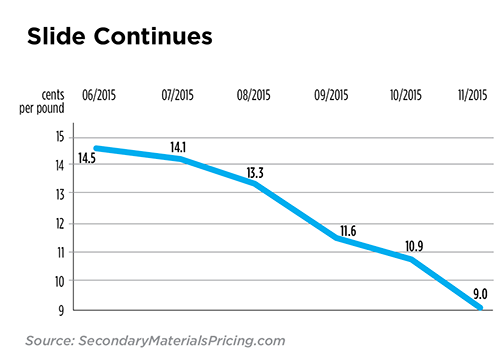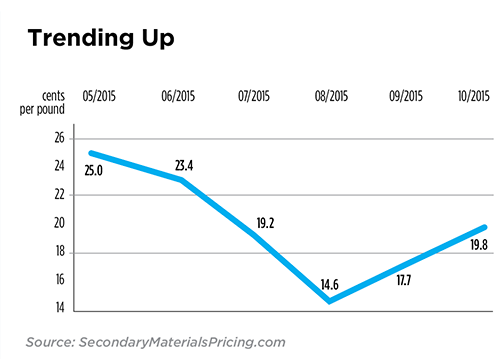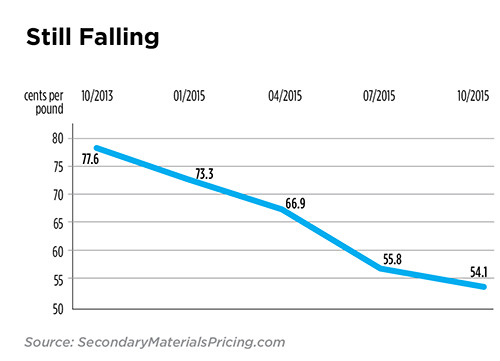PET, Aluminum Can Prices Drop; Colored HDPE Values Rise in Latest Readings
The national average prices for polyethylene terephthalate and for aluminum cans fell further in the latest index readings while post-consumer colored high-density polyethylene has started to bounce back from 2014 lows.
PET Price Trends
Late September 2015, the reported national average price for polyethylene terephthalate (PET) beverage bottles and jars had dropped from 14.5 cents per pound in June to a low of 11.6 cents per pound.
Effective October 5, the market experienced another 6-percent drop, sitting at 10.9 cents per pound. For November, the month opening national average price had reached a new low, in the 9 cents per pound range (see graph).
Currently many recycling facility managers are reporting offers to purchase in the 3-5 cents per pound range, equivalent to the industry low averages of 4 cents per pound, reported in April 2008.
These prices are as reported on the Secondary Materials Pricing (SMP) Index. This pricing represents what is being paid for post-consumer recyclable plastic materials in a sorted, baled format, picked up at most major recycling centers.

Source: www.secondarymaterialspricing.com
Post-Consumer Colored HDPE Prices Continue Upward Move
Between the second and third quarters, the national average price of post-consumer colored high-density polyethylene (HDPE) from curbside collection programs experienced a dramatic 71-percent price drop, from 25 cents per pound in May to 14.6 cents per pound in July.
However, the market for this grade started to rebound early September, moving up steadily by 35 percent, to its current national average price of 19.8 cents per pound as of October 31 (see graph).
During the same period, a smaller upward trend of 7 percent also was reported for the post-consumer natural high-density polyethylene (HDPE) grade, moving from 23.9 cents per pound to 25.6 cents per pound.
These prices are as reported on the Secondary Materials Pricing (SMP) Index. This pricing represents what is being paid for post-consumer recyclable plastic materials in a sorted, baled format, picked up at most major recycling centers.

Source: www.secondarymaterialspricing.com
Aluminum Can Prices Remain Low
During the last year, the national average price of post-consumer aluminum cans dropped gradually by 70 percent, from 77.6 cents per pound in October 2014 to 54.1 cents per pound in October 2015 (see graph).
In July the national average price had reached what was considered a low of 55.8 cents per pound. However, the price dropped an additional 3 percent, to the latest reported price of 54.1 cents per pound effective October 31.
Current indicators predict a continued November market price in the 54 to 55 cents per pound range.
These published prices are for post-consumer mill-size bales, FOB (freight on board) dealers’ plants, as reported on the Secondary Materials Pricing (SMP) Index.

Source: www.secondaryfiberpricing.com
Robert Boulanger is currently president of Recycling Markets Limited, and director of the Commodity Pricing division. He has extensive experience in the operation and management of recycling plants, and is a long-time publisher in the recycling sector.
About the Author(s)
You May Also Like


